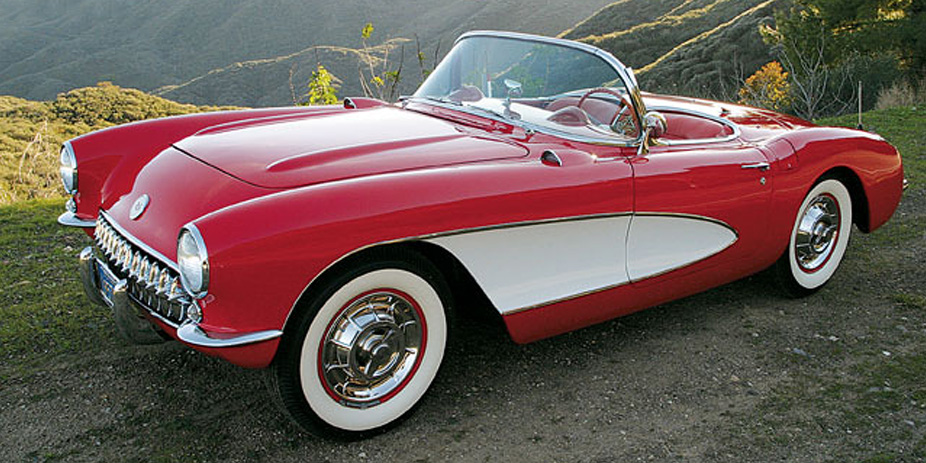1957 Corvette: The ultimate sidecar for a ’57 H-D Sportster
The world is full of wonderful alchemy. For instance, there are some epic Sister Cities, like Boring, Oregon and Dull, Scotland (really!). Also animals that just naturally work together, such as, you know, meat ants and caterpillars. And if you still have an appetite after envisioning that, there’s always tortilla chips and salsa! So why not classic cars and bikes too? I’ve owned plenty of both over the years, but never paid any particular attention to acquiring, to use a poker term, pairs. One great coupling might be a little 1961 Triumph TR3A and a 1961 Triumph T20 Tiger Cub. A Maserati Quattrovalvole and a Ducati Desmoquattro. Or a 1957 Chevy Corvette and a 1957 Harley-Davidson Sportster.
This latter pairing is beautifully and ruggedly American. In ‘57 the Corvette’s new 283-ci (4,637-cc) iron V-8 got optional fuel injection for the first time, setting a performance benchmark previously found only on products like Mercedes-Benz’s sophisticated 300 SL. Marrying a fairly standard Chevy steel box frame with a sporty fiberglass body produced a lightweight, high-performance two-seater with standout good looks and street cred. And owing to its truck-like underpinnings, the Corvettes were tough as nails.
Also enjoying a breakout year in 1957 was Harley’s new Sportster. Its 54-ci (883-cc) V-twin engine, made of steel, iron and aluminum, was a burly beast at a time when imported bikes maxed out at 650cc. The engine featured, like Corvette, overhead valves and pushrods, and brutish muscle. Likewise, the Sportster name described the bike’s intended use – stripped-down, sporty performance. And also like the base ’57 Corvette, it featured a single carburetor (if not optioned as a fuelie or with twin four-barrels) and a four-speed manual gearbox (standard on the Harley, optional on the Corvette) – just the essentials. In “bang for the buck,” at $1,103 the Sportster had a power-to-weight ratio of 12.4 lbs. per horsepower, while the $3,661 base Corvette Fuelie offered a slightly better 11.4 lbs. per horsepower.
Software engineer and racer Fred Yeakel owned a ’57 Corvette for some 42 years. “I bought it in 1965 for $500 and sold it in 2007 at auction for $105,000 – not a bad investment!” he laughs. Originally a carbureted model, Yeakel acquired it to race and eventually converted it to fuel injection. “I had been road racing a ’59 but thought the ‘57s were better looking and lighter,” he says. A dozen or so drag- and road-race appearances through 1966 brought good success, including an AHRA ¼-mile class record and a Cal Club B Production win. Still competing decades later, the car twice won at the Monterey Historic Races.
Yeakel considered our theory of certain cars and bikes being fraternal twins. “I almost bought a Sportster in 1970,” he recalls. “I thought they were cool and a lot of fun, but after racing Detroit V8s I didn’t think of a Harley V-twin as a big hulking motor. So I bought a house instead!”
Restorer and broker Glenn Bator has owned dozens of Sportsters over the years, including 10 or more 1957 models. “Whereas Harley’s big 1,200cc models were cruisers – ‘go-across-the-country’ bikes – the Sportster was the crotch rocket of the lineup,” he notes. “Basically, in ’57 the Sportster was a Hail Mary pass to compete with the British invasion of lighter, quicker postwar bikes. And it worked – if you were cool, you owned a Sportster.” Collector Mike Taggart has owned both Corvettes and Sportsters, and his perception is more finely nuanced. “The real hardcore Harley guys thought the Sportster was a ‘girls’’ bike,” he suggests. But then he agrees, “If you had a sports-car mentality, it was definitely the one you wanted.”
Not coincidentally, we suppose, both vehicles were built in hard-working, knuckle-busting Midwestern factory towns (St. Louis for the Corvette and Milwaukee for the Sportster). Both machines were long on brute force and short on creature comforts, and about as diplomatic as a ballpeen hammer. And that suits their owners just fine. As such, whether it’s on the road, at cars and coffee or in your garage, today the ’57 Corvette and ’57 Sportster clearly still belong together. As an added bit of interest, the Corvette and Sportster nameplates are now 63 and 59 years old, respectively – among the longest-running, continually produced models in American history. Along with their other similarities, this makes them not an odd couple at all, but the perfect pair.
| Vehicle | Original price | Current value | Value gain, 1957-2016 |
| 1957 Chevrolet Corvette (base Fuelie) | $3,661 | $72,600 | 1,883% |
| 1957 Harley-Davidson Sportster | $1,103 | $18,000 | 1,532% |


